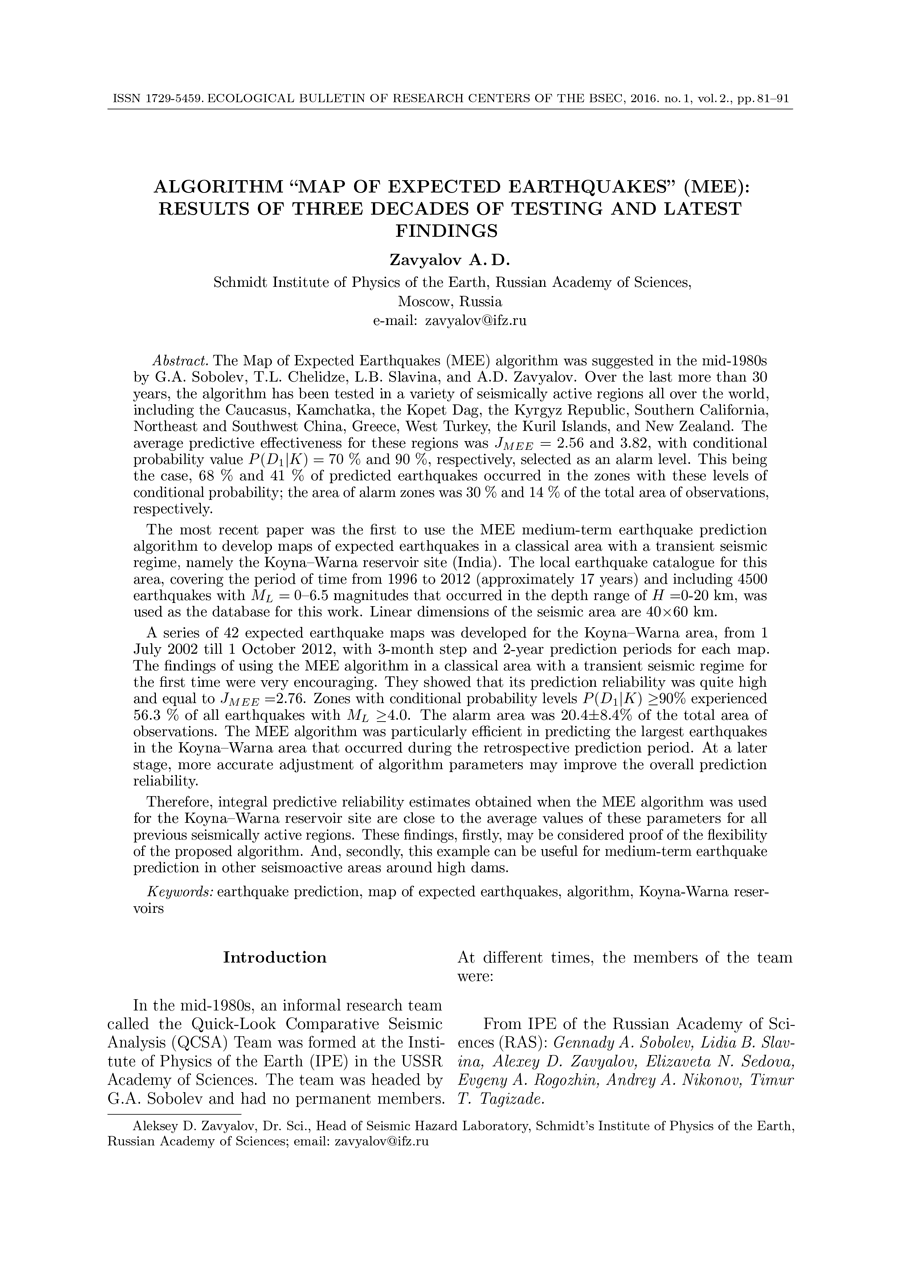Algorithm "Map of Expected Earthquakes" (MEE): results of three decades of testing and latest findings
UDC
539.3Abstract
The Map of Expected Earthquakes (MEE) algorithm was suggested in the mid-1980s by G.A. Sobolev, T.L. Chelidze, L.B. Slavina, and A.D. Zavyalov. Over the last more than 30 years, the algorithm has been tested in a variety of seismically active regions all over the world, including the Caucasus, Kamchatka, the Kopet Dag, the Kyrgyz Republic, Southern California, Northeast and Southwest China, Greece, West Turkey, the Kuril Islands, and New Zealand. The average predictive effectiveness for these regions was $J_{MEE}=2.56$ and 3.82, with conditional probability value $P(D_1|K)=70$% and 90%, respectively, selected as an alarm level. This being the case, 68% and 41% of predicted earthquakes occurred in the zones with these levels of conditional probability; the area of alarm zones was 30% and 14% of the total area of observations, respectively. The most recent paper was the first to use the MEE medium-term earthquake prediction algorithm to develop maps of expected earthquakes in a classical area with a transient seismic regime, namely the Koyna-Warna reservoir site (India). The local earthquake catalogue for this area, covering the period of time from 1996 to 2012 (approximately 17 years) and including 4500 earthquakes with $M_{L}=0$–6.5 magnitudes that occurred in the depth range of $H=0$–20 km, was used as the database for this work. Linear dimensions of the seismic area are 40×60 km. A series of 42 expected earthquake maps was developed for the Koyna-Warna area, from 1 July 2002 till 1 October 2012, with 3-month step and 2-year prediction periods for each map. The findings of using the MEE algorithm in a classical area with a transient seismic regime for the first time were very encouraging. They showed that its prediction reliability was quite high and equal to $J_{MEE}=2.76$. Zones with conditional probability levels $P(D_1|K)\ge 90$% experienced 56.3% of all earthquakes with $M_{L}\ge 4.0$. The alarm area was 20.4 ± 8.4% of the total area of observations. The MEE algorithm was particularly efficient in predicting the largest earthquakes in the Koyna-Warna area that occurred during the retrospective prediction period. At a later stage, more accurate adjustment of algorithm parameters may improve the overall prediction reliability. Therefore, integral predictive reliability estimates obtained when the MEE algorithm was used for the Koyna-Warna reservoir site are close to the average values of these parameters for all previous seismically active regions. These findings, firstly, may be considered proof of the flexibility of the proposed algorithm. And, secondly, this example can be useful for medium-term earthquake prediction in other seismoactive areas around high dams.
Keywords:
earthquake prediction, map of expected earthquakes, algorithm, Koyna-Warna reservoirsReferences
- Ventsel E.S. Probability Theory. Moscow, Nauka Publ., 1969, 576 p. (In Russian)
- Zavyalov A.D. Medium-Term Earthquake Prediction: Fundamentals, Methodology, Implementation. Moscow, Nauka Publ., 2006, 254 p. (In Russian)
- Kutsenko M.O., Zavyalov A.D. Probability of an Earthquake in the Expectation Time Interval Based on a Set of Predictive Characteristics. In Proc. of the 12th Urals Youth Scientific School for Geophysics. Perm, 21-25 March 2011, p. 131-136. (In Russian)
Downloads
Issue
Pages
Submitted
Published
How to Cite
Copyright (c) 2016 Zavyalov A.D.

This work is licensed under a Creative Commons Attribution 4.0 International License.




